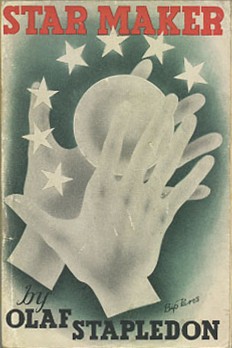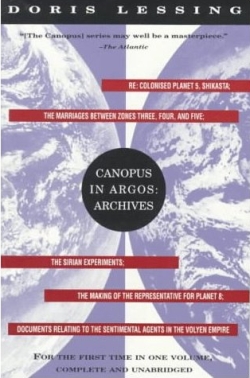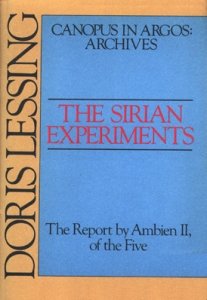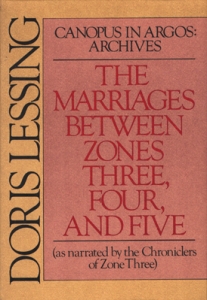
Doris May Lessing was a British novelist. She was born to British parents in Iran, where she lived until 1925. Her family then moved to Southern Rhodesia, where she remained until moving in 1949 to London, England. Her novels include The Grass Is Singing (1950), the sequence of five novels collectively called Children of Violence (1952–1969), The Golden Notebook (1962), The Good Terrorist (1985), and five novels collectively known as Canopus in Argos: Archives (1979–1983).

Star Maker is a science fiction novel by British writer Olaf Stapledon, published in 1937. The book describes a history of life in the universe, dwarfing in scale Stapledon's previous book, Last and First Men (1930), a history of the human species over two billion years. Star Maker tackles philosophical themes such as the essence of life, of birth, decay and death, and the relationship between creation and creator. A pervading theme is that of progressive unity within and between different civilisations.

Re: Colonised Planet 5, Shikasta is a 1979 science fiction novel by Doris Lessing, and is the first book in her five-book Canopus in Argos series. It was first published in the United States in December 1980 by Alfred A. Knopf, and in the United Kingdom in November 1979 by Jonathan Cape. Shikasta is also the name of the fictional planet featured in the novel.
Flight is the process by which an object moves without direct support from a surface.
Leonora or Leonara may refer to:

Doris Okada Matsui is an American politician, who has served as a member of the United States House of Representatives from California's 7th congressional district since 2005. The district, numbered as the 5th from 2005 to 2013 and the 6th from 2013 to 2023, is based in Sacramento.

Charles Adlard is a British comic book artist known for his work on books such as The Walking Dead and Savage.
Science fiction opera is a subgenre of science fiction. It refers to operas whose subject-matter fits in the science fiction genre. Like science-fiction literature, science-fiction operas may be set in the future and involve spaceflight or alien invasion. Other science-fiction operas focus on a dystopian view of the future. Like Lorin Maazel's opera 1984, they may be based on a previously written science fiction book.

Canopus in Argos: Archives is a sequence of five science fiction novels by Nobel laureate author Doris Lessing, which portray a number of societies at different stages of development, over a great period of time. The focus is on accelerated evolution guided by advanced species for less advanced species and societies.

The Sirian Experiments is a 1980 science fiction novel by Doris Lessing. It is the third book in her five-book Canopus in Argos series and continues the story of Earth's evolution, which has been manipulated from the beginning by advanced extraterrestrial civilisations. It was first published in the United States in December 1980 by Alfred A. Knopf, and in the United Kingdom in March 1981 by Jonathan Cape. The book was shortlisted for the Booker Prize in 1981.

The Marriages Between Zones Three, Four and Five is a 1980 science fiction novel by Doris Lessing. It is the second book in her five-book Canopus in Argos series, the first being Shikasta (1979). It was first published in the United States in March 1980 by Alfred A. Knopf, and in the United Kingdom in May 1980 by Jonathan Cape.

The Making of the Representative for Planet 8 is a 1982 science fiction novel by Doris Lessing. It is the fourth book in her five-book Canopus in Argos series and relates the fate of a planet, under the care of the benevolent galactic empire Canopus, that is plunged into an ice age. It was first published in the United States in January 1982 by Alfred A. Knopf, and in the United Kingdom in March 1982 by Jonathan Cape.

(Documents Relating to) The Sentimental Agents in the Volyen Empire is a 1983 science fiction novel by Doris Lessing. It is the fifth book in her five-book Canopus in Argos series and comprises a set of documents that describe the final days of the Volyen Empire, located at the edge of our galaxy and under the influence of three other galactic empires, the benevolent Canopus, the tyrannical Sirius, and the malicious Shammat of Puttiora. It was first published in the United States in March 1983 by Alfred A. Knopf, and in the United Kingdom in May 1983 by Jonathan Cape.

The Good Terrorist is a 1985 political novel written by the British novelist Doris Lessing. The book's protagonist is the naïve drifter Alice, who squats with a group of radicals in London and is drawn into their terrorist activities.

The Making of the Representative for Planet 8 is a full-scale opera by Philip Glass with a libretto by Doris Lessing based on her novel of the same name, first performed in 1988. Together with Glass's 1997 opera The Marriages Between Zones Three, Four and Five, it is part of a planned trilogy of operas based on Lessing's Canopus in Argos novels.
This page is based on this
Wikipedia article Text is available under the
CC BY-SA 4.0 license; additional terms may apply.
Images, videos and audio are available under their respective licenses.











